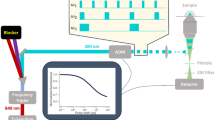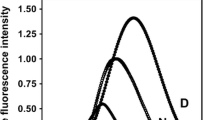Abstract
Transitions in the tryptophan microenvironment and secondary structure of two monocot lectins from Sauromatum guttatum and Arisaema tortuosum under different denaturing conditions were studied by steady state and time resolved fluorescence and CD spectroscopy. The lectins exist as tetramers with a single tryptophan residue estimated per monomer, present in a polar environment. Quenching with ionic quenchers showed predominantly electropositive environment for tryptophan residues. Acrylamide had maximum quenching effect. A decrease in KI quenching due to lectin denaturation indicated redistribution of charges as a result of possible conformational change. The two values for lifetimes of tryptophanyl population (1.2–1.4 and 6.3–6.4 ns) reduced substantially on quenching or denaturation. Similarly, both the lectins showed a drastic loss of secondary structure in 5 M Gdn-HCl or 6 M Urea or at pH 2.0 and below. For the first time araceous lectins, like legume lectins are shown to bind adenine. The presence of a compact structure at alkaline pH 10.0–12.0 was observed in CD spectra.




Similar content being viewed by others
References
Burstein EA, Vedenkina NS, Ivkova MN (1973) Fluorescence and the location of tryptophan residues in protein molecules. Photochem Photobiol 18(4):263–279 doi:10.1111/j.1751-1097.1973.tb06422.x
Lakowicz EM, Weber G (1973) Quenching of protein fluorescence by oxygen. Detection of structural fluctuations in proteins on the nanosecond time scale. Biochemistry 12:4171–4179 doi:10.1021/bi00745a021
Demchenko AP (1986) Fluorescence analysis of protein dynamics. Essays Biochem 22:120–157
Wright LM, Wood SD, Reynolds CD, Rizkallah PJ, Peumans WJ, Van Damme EJM et al (1996) Purification, crystallization and preliminary X-ray analysis of a mannose-binding lectin from bluebell (Scilla campanulata) bulbs. Acta Crystallogr D52:1021–1023
Van Damme EJM, Allen AK, Peumans WJ (1988) Related mannose-specific lectins from different species of the family Amaryllidaceae. Physiol Plant 73:52–57 doi:10.1111/j.1399-3054.1988.tb09192.x
Peumans WJ, Kellens JT, Allen AK, Van Damme EJM (1991) Isolation and characterization of a seed lectin from elderberry (Sambucus nigra L.) and its relationship to the bark lectins. Carbohydr Res 213:7–17 doi:10.1016/S0008-6215(00)90593-7
Van Damme EJM, Goossens K, Smeets K, Van Leuven F, Erhaert P, Peumans WJ (1995) The major tuber storage protein of araceae species is a lectin. Characterization and molecular cloning of the lectin from Arum maculatum, L. Plant Physiol 107:1147–1158 doi:10.1104/pp.107.4.1147
Van Damme EJM, Peumans WJ, Barre A, Rougé P (1998) Plant lectins: A composite of several distinct families of structurally and evolutionary related proteins with diverse biological roles. Crit Rev Plant Sci 17:645–662 doi:10.1016/S0735-2689(98)00365-7
Kamboj SS, Shangary S, Singh J, Kamboj KK, Sandhu RS (1995) New lymphocyte stimulating monocot lectins from family Araceae. Immunol Invest 24(5):845–855 doi:10.3109/08820139509060711
Shangary S, Singh J, Kamboj SS, Kamboj KK, Sandhu RS (1995) Purification and properties of four monocot lectins from the family araceae. Phytochemistry 40:449–455 doi:10.1016/0031-9422(95)00229-Z
Dhuna V, Bains JS, Kamboj SS, Singh J, Shanmugavel, Saxena AJ (2005) Purification and Characterization of a Lectin from Arisaema tortuosum Schott Having in-vitro Anticancer Activity against Human Cancer cell lines. J Biochem Mol Biol 38(5):526–532
Kaur A, Kamboj SS, Singh J, Saxena AK, Dhuna V (2005) Isolation of a novel N-acetyl-D-lactosamine specific lectin from Alocasia cucullata (Schott.). Biotechnol Lett 27:1815–18220 doi:10.1007/s10529-005-3559-y
Singh J, Kamboj SS, Sandhu RS, Shangary S, Kamboj KK (1993) Purification and characterization of a tuber lectin from Alocasia indica. Phytochemistry 33:979–983 doi:10.1016/0031-9422(93)85007-E
Allen AK, Neurberger A, Sharon N (1973) The purification, composition and specificity of wheat-germ agglutinin. Biochem J 131(1):155–162
Kamboj SS, Shangary S, Singh J, Kamboj KK, Sandhu RS (1995) New lymphocyte stimulating monocot lectins from family Araceae. Immunol. Invest. 24(5):845–855 doi:10.3109/08820139509060711
Shangary S, Kamboj SS, Singh J, Kamboj KK, Sandhu RS (1996) New lymphocyte stimulating monocot lectins from family Araceae. Immunol. Invest. 25(4):273–278 doi:10.3109/08820139609059310
Singh J, Kamboj SS (2004) A novel mitogenic and antiproliferative lectin from a wild cobra lily, Arisaema flavum. Biochem Biophys Res Commun 318:1057–1065 doi:10.1016/j.bbrc.2004.04.135
Kaur M, Rup PJ, Saxena AK, Khan RH, Ashraf MT, Kamboj SS et al (2006) A tuber lectin from Arisaema helleborifolium Schott with anti-insect activity against melon fruit Xy, Bactrocera cucurbitae (Coquillett) and anti-cancer effect on human cancer cell lines. Arch Biochem Biophys 445:156–165 doi:10.1016/j.abb.2005.10.021
Dhuna V, Bains JS, Kamboj SS, Singh J, Shanmugavel, Saxena AJ (2007) Purification and Characterization of a Lectin from Arisaema tortuosum Schott having in-vitro Anticancer Activity against Human Cancer Cell Lines. J Biochem Mol Biol 38:526–532
Spande TF, Witkop B (1967) Determination of the tryptophan content of proteins with N-bromosuccinimide. Methods Enzymol 11:498–506 doi:10.1016/S0076-6879(67)11060-4
Ali V, Prakash K, Kulkarni S, Ahmad A, Madhusudan KP, Bhakuni V (1999) 8-anilino-1-naphthalene sulfonic acid (ANS) induces folding of acid unfolded cytochrome c to molten globule state as a result of electrostatic interactions. Biochemistry 38(41):13635–13642 doi:10.1021/bi9907835
Gasymov OK, Glasgow BJ (2007) ANS fluorescence: Potential to augment the identification of the external binding sites of proteins. Biochim Biophys Acta 1774(3):403–411
Watanabe K, Honjo E, Tsukamoto T, Funatsu G (1992) Fluorescence studies on the interaction of adenine with ricin A chain. FEBS Lett 304:249–251 doi:10.1016/0014-5793(92)80630-Y
Chipman DM, Grisaro V, Sharon N (1967) The binding of oligosaccharides containing N-acetylglucosamine and N-acetylmuramic acid to lysozyme. J Biol Chem 242:4388–4394
Siddiqui MZ, Sharma AK, Kumar S (1996) Solution conformation of tuftsin. Int J Biol Macromol 19(2):99–102 doi:10.1016/0141-8130(96)01108-7
Eftink MR, Ghiron CA (1984) Indole fluorescence quenching studies on proteins and model systems: use of the inefficient quencher succinimide. Biochemistry 23:3891–3889 doi:10.1021/bi00312a016
Katre UV, Suresh CG, Khan MI, Gaikwad SM (2007) Steady state and time-resolved fluorescence studies of a hemagglutinin from Moringa oleifera. J Fluoresc 18(2):479–485 doi:10.1007/s10895-007-0289-7
Komath SS, Swamy MJ (1999) Fluorescence quenching, time resolved fluorescence and chemical modification studies on the tryptophan residues of snake gourd (Trichosanthes anguina) seed lectin. J Photochem Photobiol B Biol 50:108–118 doi:10.1016/S1011-1344(99)00079-2
Kenoth R, Swamy MJ (2003) Steady-state and time-resolved fluorescence studies on Trichosanthes cucumerina seed lectin. J Photochem Photobiol B Biol 69:193–201
Sultan NAM, Swamy MJ (2005) Fluorescence quenching and time-resolved fluorescence studies on Trichosanthes dioica seed lectin. J Photochem Photobiol B Biol 80:93–100 doi:10.1016/j.jphotobiol.2005.03.003
Sultan NAM, Rao RN, Nadimpalli SK, Swamy MJ (2006) Tryptophan environment, secondary structure and thermal unfolding of the galactose-specific seed lectin from Dolichos lablab: Fluorescence and circular dichroism spectroscopic studies. Biochim Biophys Acta 1760:1001–1008
Lehrer SS (1971) Solute perturbation of protein fluorescence. The quenching of tryptophyl fluorescence of model compounds and of lysozyme by iodide ion. Biochemistry 10:3254–3263 doi:10.1021/bi00793a015
Etzler ME, Gupta S, Borrebaeck C (1981) Carbohydrate binding properties of the Dolichos biflorus lectin and its subunits. J Biol Chem 256:2367–2370
Gegg CV, Roberts DD, Segel IH, Etzler ME (1992) Characterization of the adenine binding sites of two Dolichos biflorus Lectins. Biochemistry 31:6938–6942 doi:10.1021/bi00145a011
Roberts DD, Goldstein IJ (1983) Adenine binding sites of the lectin from lima beans (Phaseolus lunatus). J Biol Chem 258:13820–13824
Puri KD, Surolia A (1994) Amino acid sequence of the Winged Bean (Psophocarpus tetragonolobus) basic lectin. Adenine binding and identification of the active-site tryptophan residue. J Biol Chem 269:30917–30926
Author information
Authors and Affiliations
Corresponding author
Rights and permissions
About this article
Cite this article
Dharker, P.N., Gaikwad, S.M., Suresh, C.G. et al. Comparative Studies of Two Araceous Lectins by Steady State and Time-Resolved Fluorescence and CD Spectroscopy. J Fluoresc 19, 239–248 (2009). https://doi.org/10.1007/s10895-008-0409-z
Received:
Accepted:
Published:
Issue Date:
DOI: https://doi.org/10.1007/s10895-008-0409-z




